Georges (or George) Rigaud (1905-1984) was a noted Argentine film actor, who started his career in the French cinema of the 1930s. His best known film is René Clair’s classic comedy Quatorze Juillet (1932). Rigaud also played in Italian, American, Argentine and Spanish films. Between 1932 and 1981, he appeared in 194 films.

German postcard by Ross Verlag, no. 8025/1, 1933-1934. Photo: Ufa.
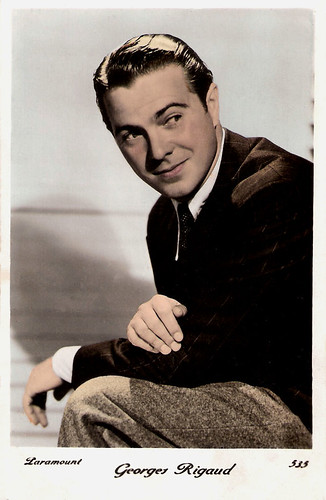
French postcard, no. 535. Photo: Paramount.
Georges (or George) Rigaud was born Pedro Jorge Rigato Delissetche in Buenos Aires, Argentina, in 1905. In 1931, he moved to France, where he made his film debut with a bit part in Grains de beauté/Beauty Spot (Pierre Caron, Léonce Perret, 1932). That same year he played a bigger role in the crime film Fantômas (Pál Fejös, 1932), starring Jean Galland.
His best known film is René Clair’s classic comedy Quatorze Juillet (1932). Hal Erickson at AllMovie: “Quatorze Juliet translates to "July 14th"--and if you know your French history, you'll know that July 14th is Bastille Day. This Rene Clair film deals not with the tumultuous events of the French Revolution, but with a 1932 celebration of that particular French holiday. The hero, George Rigaud, is a Parisian cabdriver; the heroine, Annabella, is a flower peddler. As the Bastille Day festivities stretch on into the night, the young lovers come in contact with several of Paris' more eccentric citizens. Director Clair felt that Quatorze Juliet was better in parts than in sum total; modern audiences will most likely enjoy the film as a whole, excusing the weaknesses of its structure while revelling in its music and atmosphere.”
The following year, Rigaud starred opposite Renate Müller in the comedy Idylle au Caire (Claude Heymann, Reinhold Schünzel, 1933). It was an alternate language version of the Ufa production Saison in Kairo/Season in Cairo (Reinhold Schünzel, 1933). He then starred in the historical drama Une histoire d'amour/A Love Story (Max Ophüls, 1933), based on Arthur Schnitzler's play Liebelei about a musician's daughter in 1890s Imperial Vienna who falls in love with a young army officer, only for him to be killed in a duel. It is a French-language version of Liebelei (Max Ophüls, 1933).
Popular was also the drama Nitchevo (Jacques de Baroncelli, 1936) starring Harry Baur, which is a remake of the 1926 silent film of the same name. Less successful was the musical La vie parisienne/Parisian Life (Robert Siodmak, 1936) starring Max Dearly, Conchita Montenegro and Rigaud, and based on the opera La vie parisienne. The production caused financial problems for its company, Nero Film, run by the émigré producer Seymour Nebenzal.
Other French films in which he appeared were the drama Nuits de feu/Nights of Fire (Marcel L'Herbier, 1937), starring Gaby Morlay, Sarati, le terrible/Sarati the Terrible (André Hugon, 1937), featuring Harry Baur, and the adventure film Puits en flammes/Wells in Flames (Viktor Tourjansky, 1937).
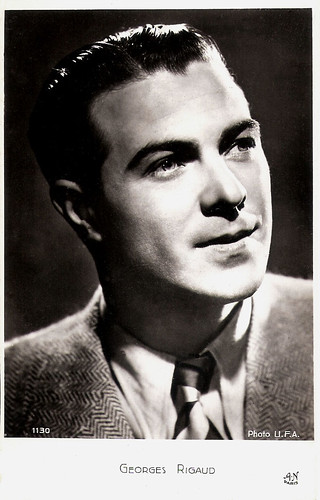
French postcard by A.N., Paris, no. 1130. Photo: Ufa.
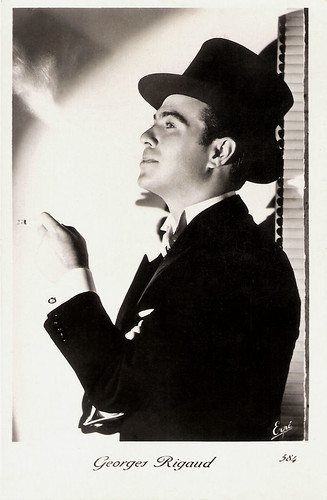
French postcard by Erpé, no. 384.
In Italy, Georges Rigaud starred opposite Corinne Luchaire in the drama Abbandono (Mario Mattoli, 1940). Then followed a short period in Hollywood, where he appeared in Paris Underground (Gregory Ratoff, 1945), Masquerade in Mexico (Mitchell Leisen, 1945), and the Film Noir I Walk Alone (Byron Haskin, 1948) starring Burt Lancaster.
After this he returned to Argentina, and co-starred with Zully Moreno in the thriller La trampa/The Trap (Carlos Hugo Christensen, 1949). He had a supporting part in Sangre negra/Native Son (Pierre Chenal, 1951).
In 1957, he moved definitely to Spain, where he continued his film career credited as Jorge Rigaud. His Spanish films include the drama Mi calle/My Street (Edgar Neville, 1960), Vuelve San Valentín/St. Valentine Returns (Fernando Palacios, 1962), and Estambul 65/That Man in Istanbul (Antonio Isasi-Isasmendi, 1965) starring Horst Buchholz.
His parts were now mostly supporting roles. He worked in Italy where he appeared in the Peplum Il Colosso di Rodi/The Colossus of Rhodes (1961), directed by Sergio Leone, and starring Rory Calhoun. In Hollywood he played in the flop The Happy Thieves (George Marshall, 1961), a crime/comedy-drama film starring Rex Harrison and Rita Hayworth. And in France he had a part in the Alain Delon vehicle La Tulipe noire/The Black Tulip (Christian-Jacque, 1964).
Rigaud also was seen in some Eurospy films and Spaghetti Westerns. Interesting were the Italian crime film Ad ogni costo/Grand Slam (Giuliano Montaldo, 1967), starring Janet Leigh, and the Giallo Una lucertola con la pelle di donna/Schizoid (Lucio Fulci, 1971) with Florinda Balkan as the daughter of a respected politician, who experiences a series of vivid, psychedelic nightmares consisting of depraved sex orgies and LSD use. Later films are Pánico en el Transiberian/Horror Express (Eugenio Martín, 1972), starring Christopher Lee and Peter Cushing, and Maravillas (Manuel Gutiérrez Aragón, 1980).
In 1981, Georges Rigaud died in a road accident in Madrid, Spain. He was 78.
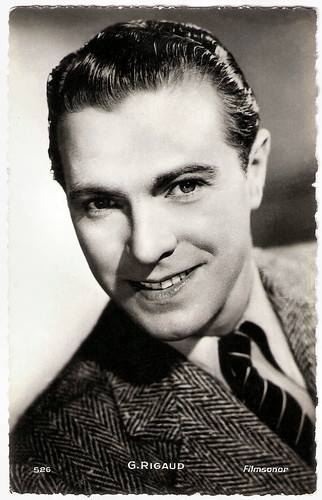
French postcard by Ed. Chantal, no. 526. Photo: Filmsonor.
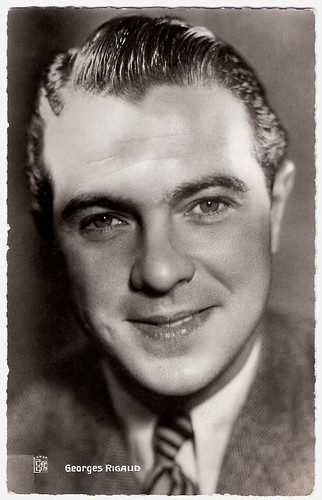
French postcard by Editions et Publications Cinematographiques (EPC), no. 159.
Sources: Hal Erickson (AllMovie), José L. Bernabé Tronchoni (Find A Grave), Wikipedia and IMDb.

German postcard by Ross Verlag, no. 8025/1, 1933-1934. Photo: Ufa.

French postcard, no. 535. Photo: Paramount.
14 July
Georges (or George) Rigaud was born Pedro Jorge Rigato Delissetche in Buenos Aires, Argentina, in 1905. In 1931, he moved to France, where he made his film debut with a bit part in Grains de beauté/Beauty Spot (Pierre Caron, Léonce Perret, 1932). That same year he played a bigger role in the crime film Fantômas (Pál Fejös, 1932), starring Jean Galland.
His best known film is René Clair’s classic comedy Quatorze Juillet (1932). Hal Erickson at AllMovie: “Quatorze Juliet translates to "July 14th"--and if you know your French history, you'll know that July 14th is Bastille Day. This Rene Clair film deals not with the tumultuous events of the French Revolution, but with a 1932 celebration of that particular French holiday. The hero, George Rigaud, is a Parisian cabdriver; the heroine, Annabella, is a flower peddler. As the Bastille Day festivities stretch on into the night, the young lovers come in contact with several of Paris' more eccentric citizens. Director Clair felt that Quatorze Juliet was better in parts than in sum total; modern audiences will most likely enjoy the film as a whole, excusing the weaknesses of its structure while revelling in its music and atmosphere.”
The following year, Rigaud starred opposite Renate Müller in the comedy Idylle au Caire (Claude Heymann, Reinhold Schünzel, 1933). It was an alternate language version of the Ufa production Saison in Kairo/Season in Cairo (Reinhold Schünzel, 1933). He then starred in the historical drama Une histoire d'amour/A Love Story (Max Ophüls, 1933), based on Arthur Schnitzler's play Liebelei about a musician's daughter in 1890s Imperial Vienna who falls in love with a young army officer, only for him to be killed in a duel. It is a French-language version of Liebelei (Max Ophüls, 1933).
Popular was also the drama Nitchevo (Jacques de Baroncelli, 1936) starring Harry Baur, which is a remake of the 1926 silent film of the same name. Less successful was the musical La vie parisienne/Parisian Life (Robert Siodmak, 1936) starring Max Dearly, Conchita Montenegro and Rigaud, and based on the opera La vie parisienne. The production caused financial problems for its company, Nero Film, run by the émigré producer Seymour Nebenzal.
Other French films in which he appeared were the drama Nuits de feu/Nights of Fire (Marcel L'Herbier, 1937), starring Gaby Morlay, Sarati, le terrible/Sarati the Terrible (André Hugon, 1937), featuring Harry Baur, and the adventure film Puits en flammes/Wells in Flames (Viktor Tourjansky, 1937).

French postcard by A.N., Paris, no. 1130. Photo: Ufa.

French postcard by Erpé, no. 384.
France - Argentina - Italy - Hollywood - France - Spain
In Italy, Georges Rigaud starred opposite Corinne Luchaire in the drama Abbandono (Mario Mattoli, 1940). Then followed a short period in Hollywood, where he appeared in Paris Underground (Gregory Ratoff, 1945), Masquerade in Mexico (Mitchell Leisen, 1945), and the Film Noir I Walk Alone (Byron Haskin, 1948) starring Burt Lancaster.
After this he returned to Argentina, and co-starred with Zully Moreno in the thriller La trampa/The Trap (Carlos Hugo Christensen, 1949). He had a supporting part in Sangre negra/Native Son (Pierre Chenal, 1951).
In 1957, he moved definitely to Spain, where he continued his film career credited as Jorge Rigaud. His Spanish films include the drama Mi calle/My Street (Edgar Neville, 1960), Vuelve San Valentín/St. Valentine Returns (Fernando Palacios, 1962), and Estambul 65/That Man in Istanbul (Antonio Isasi-Isasmendi, 1965) starring Horst Buchholz.
His parts were now mostly supporting roles. He worked in Italy where he appeared in the Peplum Il Colosso di Rodi/The Colossus of Rhodes (1961), directed by Sergio Leone, and starring Rory Calhoun. In Hollywood he played in the flop The Happy Thieves (George Marshall, 1961), a crime/comedy-drama film starring Rex Harrison and Rita Hayworth. And in France he had a part in the Alain Delon vehicle La Tulipe noire/The Black Tulip (Christian-Jacque, 1964).
Rigaud also was seen in some Eurospy films and Spaghetti Westerns. Interesting were the Italian crime film Ad ogni costo/Grand Slam (Giuliano Montaldo, 1967), starring Janet Leigh, and the Giallo Una lucertola con la pelle di donna/Schizoid (Lucio Fulci, 1971) with Florinda Balkan as the daughter of a respected politician, who experiences a series of vivid, psychedelic nightmares consisting of depraved sex orgies and LSD use. Later films are Pánico en el Transiberian/Horror Express (Eugenio Martín, 1972), starring Christopher Lee and Peter Cushing, and Maravillas (Manuel Gutiérrez Aragón, 1980).
In 1981, Georges Rigaud died in a road accident in Madrid, Spain. He was 78.

French postcard by Ed. Chantal, no. 526. Photo: Filmsonor.

French postcard by Editions et Publications Cinematographiques (EPC), no. 159.
Sources: Hal Erickson (AllMovie), José L. Bernabé Tronchoni (Find A Grave), Wikipedia and IMDb.
No comments:
Post a Comment